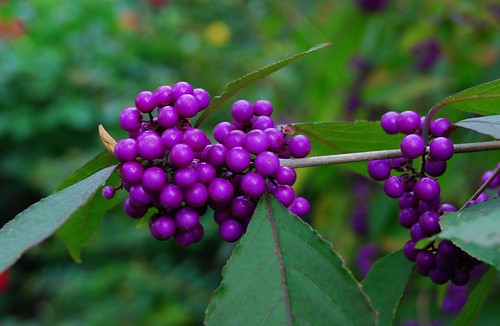
                                          Photo by natureloving
TheGardenLady had never seen a bush with such magnificent fall berries until she walked around her town one fall and saw a shrub with magenta berries on it. Once seen TheGardenLady had to have this shrub; but when she first asked its name - Callycarpa Americana – it seemed difficult to remember. And its common name with Beauty in it, was also difficult to recall because there is beauty as part of other common plant names. But once TheGardenLady learned that Callicarpa is derived from the Greek words kallos (beauty) and karpos (fruit); Linnaeus named it americana to distinguish it from the old-world species, this TheGardenLady could never forget the name.
It had to be given the name whether in Greek or in English of Beauty Berry because of the strikingly bright magenta berries that are profuse on all the branches-the berries on some shrubs are said to be pink through violet. And there are also white berried Callicarpa americana – var. lactea or other white berried callicarpas.
Callicarpa is a deciduous shrub that has insignificant pink flowers. In late summer and fall the berries come out with the color so stunning, one cannot miss seeing it. This native plant grows from zone 6 to Zone 10b all around the USA. It is native plant that deer on TheGardenLady’s property don’t seem to eat ; but I have read that it is a favorite plant of the white tailed deer. Birds, especially the Northern Bobwhite, enjoy the beautyberry fruit and the flower is a butterfly and bee attractant. It is not a favorite fruit of birds so that it is one of the last fruits the birds will eat; thus humans can enjoy the explosion of color for months, even after the leaves fall off.
This is an easy plant to grow in almost any soil and when established it can withstand drought conditions. It likes sunlight and dappled sunlight. Therefore it can happily grow under many trees. The shrub can be started from seeds or from root cuttings and softwood tip cuttings. A friend started TheGardenLady’s shrub from her tip cuttings.
Â
TheGardenLady read that Callicarpa americana has disappeared from a lot of the wilderness areas where it had grown. So by planting Callicarpa in your gardens, you are helping to reestablish this stunning native plant. (Warning: Parts of the plant are poisonous if eaten.)
Â
